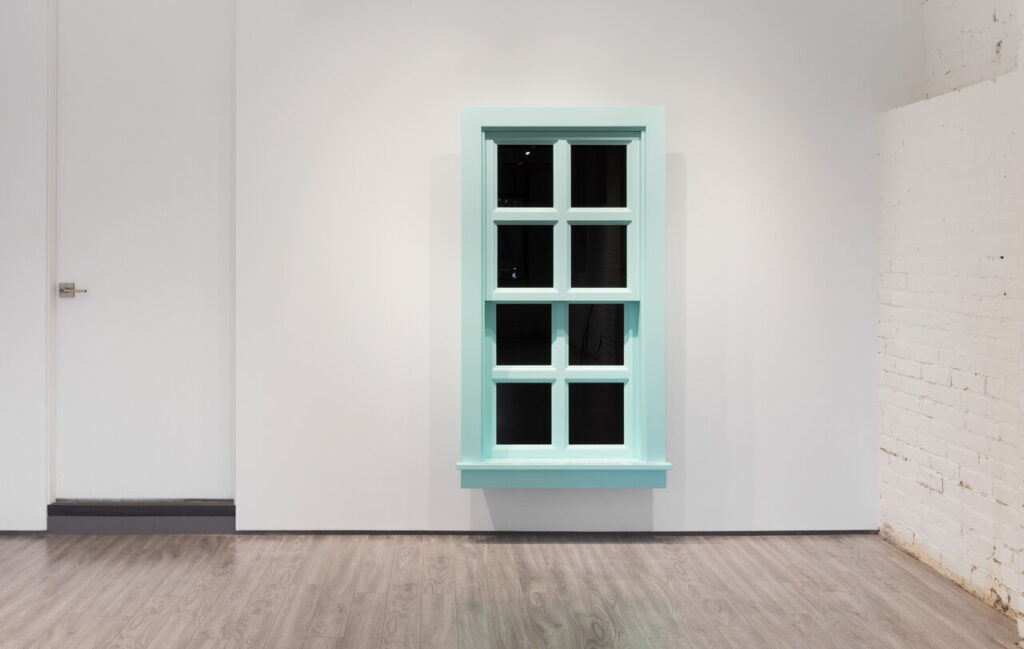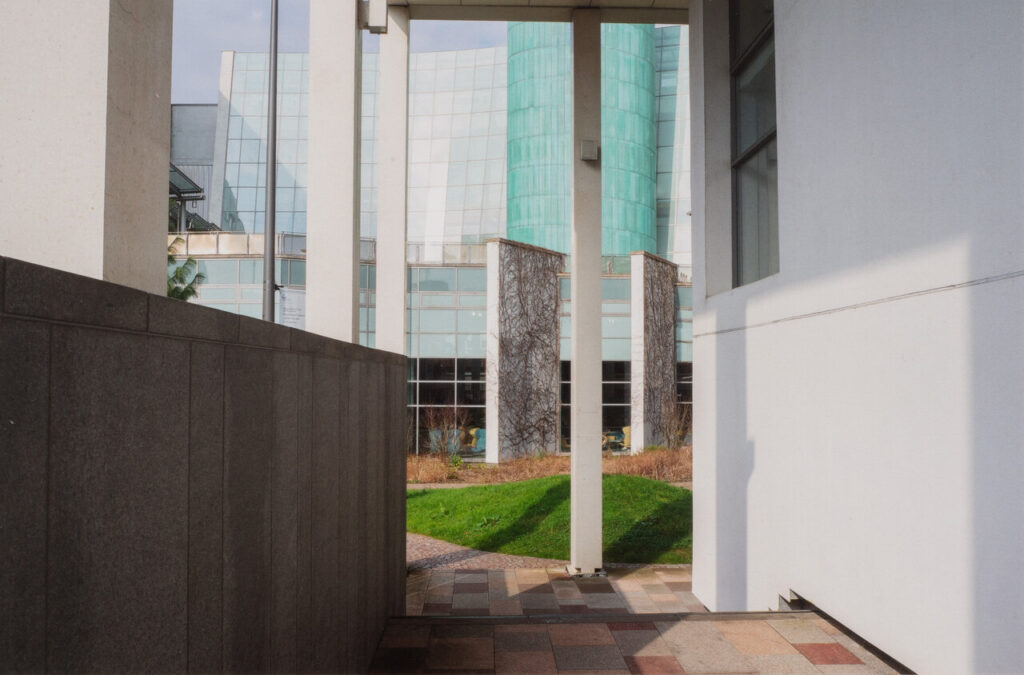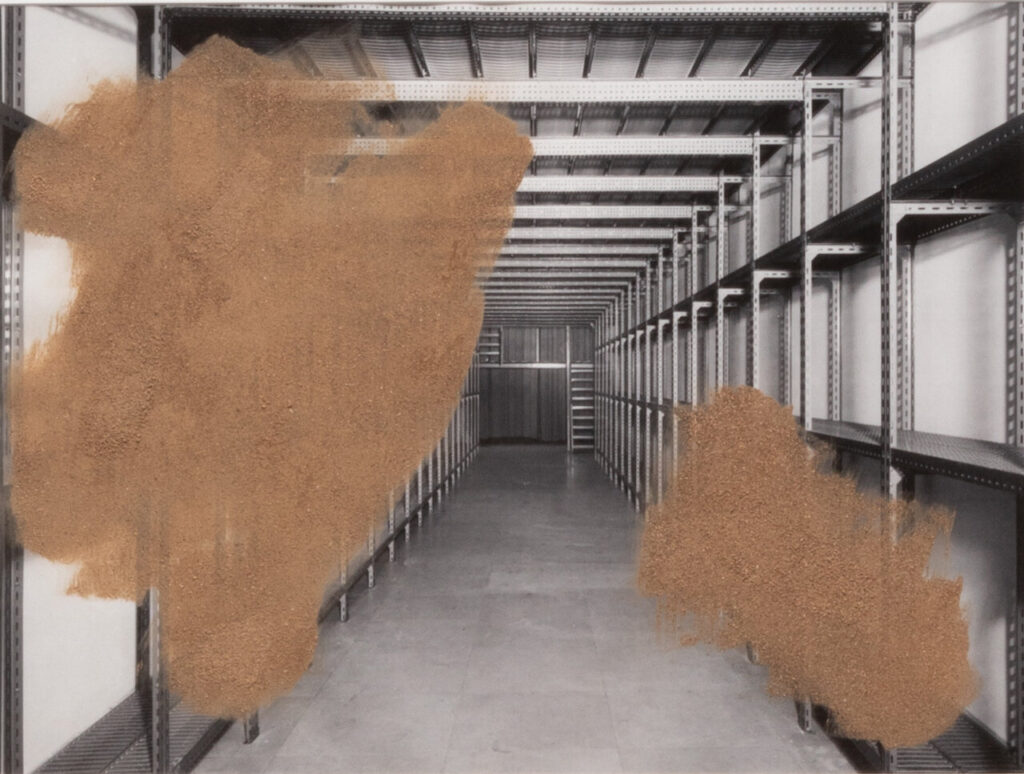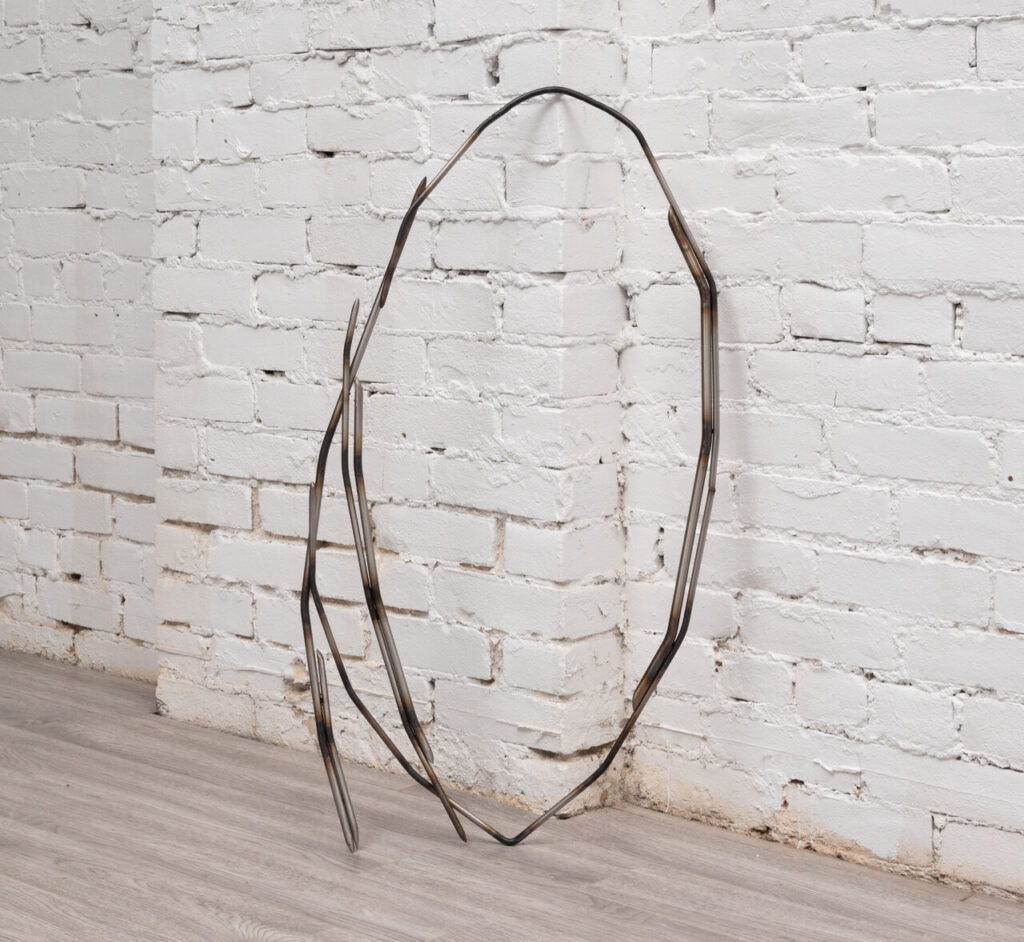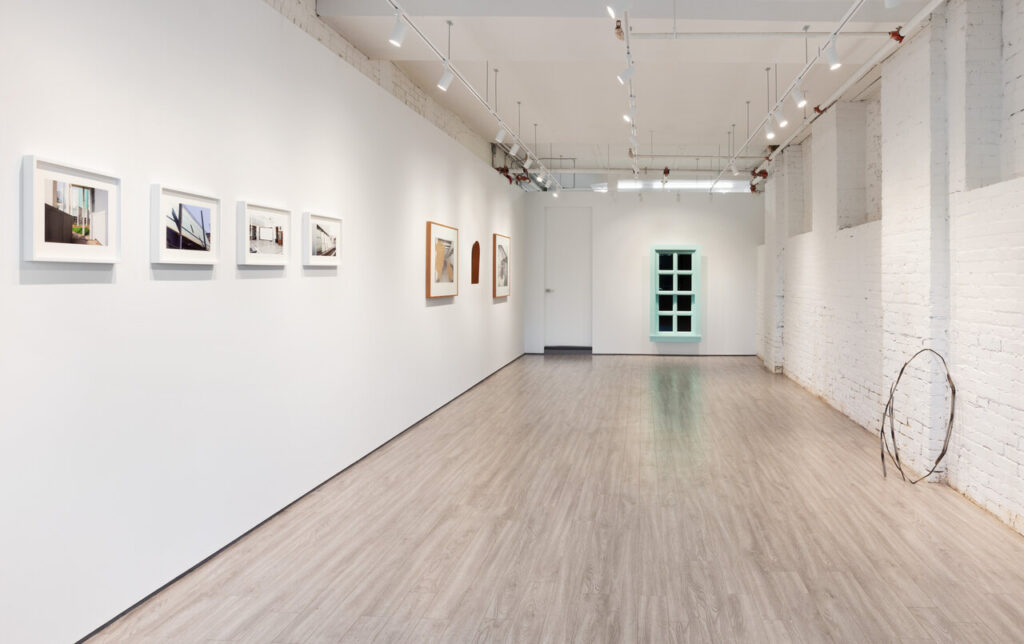Finding Towards Gallery is a little challenging. In a building located almost opposite MOCA, the gallery is on the north side. Most of the units in the building are accessed inside, but the gallery is accessed from a lane off the street. The search, however, is worth it. It is a modestly sized space – one long room with natural light. The current exhibition, The Window and the Frame, showcases the works of four young conceptual artists. The exhibition is beautifully presented and very stimulating. It certainly gave me a lot to reflect on.
The most conspicuous piece in the show is a window frame with blackened glass, that hangs at knee-level on the far wall. It is a work by Dylan Macaulay titled For and After Rrose, and is described as a homage to Marcel Duchamp. Indeed, it is a oversized replica of Duchamp’s Fresh Widow (1920). The first thing I asked myself is why the artist has gone to such trouble to reproduce someone else’s work. The literature explains that Macaulay uses paint behind the glass instead of Duchamp’s original black leather, but in practical terms this difference is negligible. This fact highlights how the work is conceptual in nature. That is to say, what matters – to follow Duchamp himself – is the idea behind the work, as opposed to its ‘retinal’, i.e., aesthetic, qualities. The same can largely be said about all the works in the show.
Dylan Macaulay, For and After Rrose, 2021, wood, glass, lacquer, exterior acrylic paint and hardware, 65.5 x 30 x 9.75 in
In the past, Macaulay has produced a whole series of windows. Likely, I imagine, these were in part inspired by Duchamp’s piece. But Macaulay shares with the other artists a strong architectural influence. This influence is clearest in the case of Simon Shim-Sutcliffe, whose work for the show consists of four photographs of architectural details sampled from buildings in Europe and South America. They are a study in the construction of images. This follows a closer reading of the pictures, where we are invited to consider cropping, light and space. These seem to be banal issues facing any photography, however. What is cropped or edited out in this case, and for all the other works in the show, are people and nature more generally. This fact is unremarkable in itself, except that it is mentioned in the write-up for the show. This too is a Duchampian trait. Duchamp sought to ‘dehumanise’ his work, as he put it – to make it about man-made things, e.g., readymades or machines, rather than human beings. Likewise, Shim-Sutcliffe focusses on ‘man-made elements’.
Simon Shim–Sutcliffe, Impression of sites unseen 1. (Library of Glasgow Caledonian University), 2022, photograph printed on Canson Infinity Platine fibre rag paper, mounted to white rag board, 8 x 12 in
This same preoccupation is shared by Maria Trabulo. In this show she presents two pictures and a small wall-hung sculpture. The two pictures consist of archival photographs of storage areas in the National Museum of Ancient Art in Lisbon. Each of them has been sprinkled with dust from these areas. To what end? They are part of a series titled Collecting Dust. Obviously titles are an essential aspect to such conceptual art given the primacy of idea of any visual elements. The series, it is said, aims to represent ‘the collapsing of time, space and materials [that] highlights complex histories embedded in both these institutions and the artifacts they care for’. The works themselves, therefore, do not stand alone; rather they require an elaborate explanation of the ideas that inspired their making.
Maria Trabulo, Collecting Dust (Improvement of the deposit area for the sculpture collection (Ground Floor) – National Museum of Ancient Art Lisbon © Mário Novaes 1972), 2021, inkjet print on Museum Natural Smooth 310g/m2 paper, dust and sediments of tempera, paint, wood, stone, and clay, 17.75 x 23.75 in
That said, the work of the fourth artist in the show does appear to stand alone. It is a sculpture leaning against the painted brick wall opposite the photographic works. Titled Moon, by Rosario Aninat, it is a large zero roughly shaped from a strip or strips of metal. The title aims to suggest the Chinese ideograph for the moon. The shape itself, we are told, derives from a door handle located in the Katsura Imperial Villa built in the early seventeenth century in Japan. Here the ideas behind the work seem redundant, or even an impairment vis-à-vis the viewing of the work. It is a gorgeous sculpture in its own right, and knowing these ideas does little in the way of enhancing the experience of contemplating it.
Rosario Aninat, Moon, 2022, forged stainless steel, 35 x 19.5 in.
Likely, many will disagree with this last claim, arguing that the conceptual element to such art quite generally is essential to understanding and appreciating it. This disagreement only highlights a tension in conceptual art, namely that while it is primarily about ideas it is visually presented, and anything visual is necessarily judged aesthetically. Duchamp himself used his readymades to underscore the primacy of the intellect in his view. Most famously, in New York he submitted a urinal under the pseudonym R. Mutt. This was rejected by the board of the exhibition of the society of independent artists despite the fact that the exhibition was meant to be open to all. The board struggled to see how a mundane industrial product could be considered art at all. Duchamp argued that art ought to be considered whatever the artist chooses it to be. There is nothing intrinsic to an object that makes it art or not, and so all aesthetic considerations fall away, or are at least secondary.
Installation view of The Window and the Frame, at Towards Gallery
For my part, I see Duchamp’s use of readymades as a type of reductio ad absurdum, that is, deployed to show how we cannot rule out anything as art by virtue of any of its intrinsic properties, be they aesthetic or otherwise, without contradiction. But, this fact about the concept of art, I would stress, does not show that art is a purely intellectual endeavour. Insofar as the artists in this show are primarily concerned with the ideas, there is a sense in which aesthetic choices they make in the visual presentation of their works are incidental. By this I mean that these choices offer few clues to the ideas the works embody. The ideas are too complex to be communicated by visual means alone. As a result the artworks as objects can appear as mere addenda, rather than central elements. The artworks are nonetheless aesthetically sophisticated, tempting the viewer to ignore the ideas themselves and simply enjoy them as objects.
Hugh Alcock
Images are courtesy of Towards Gallery
*Exhibition information: The Window and the Frame, August 4 – September 2, 2022, Towards Gallery, 163 Sterling Ave, Unit 144, Toronto. Gallery hours: Thurs – Sat, 12 – 6 pm.

